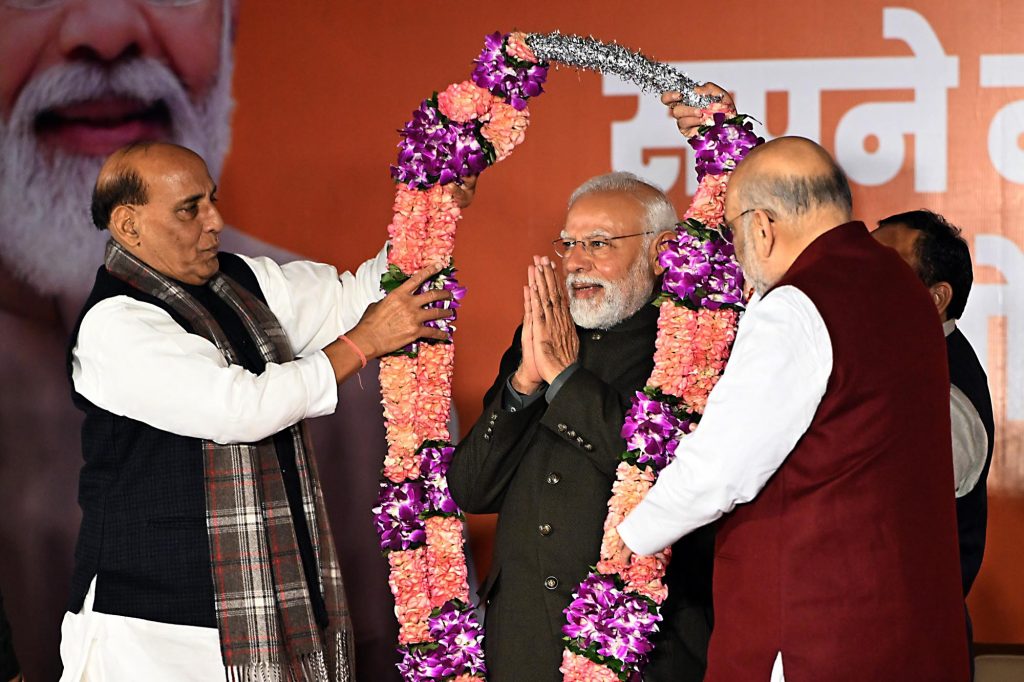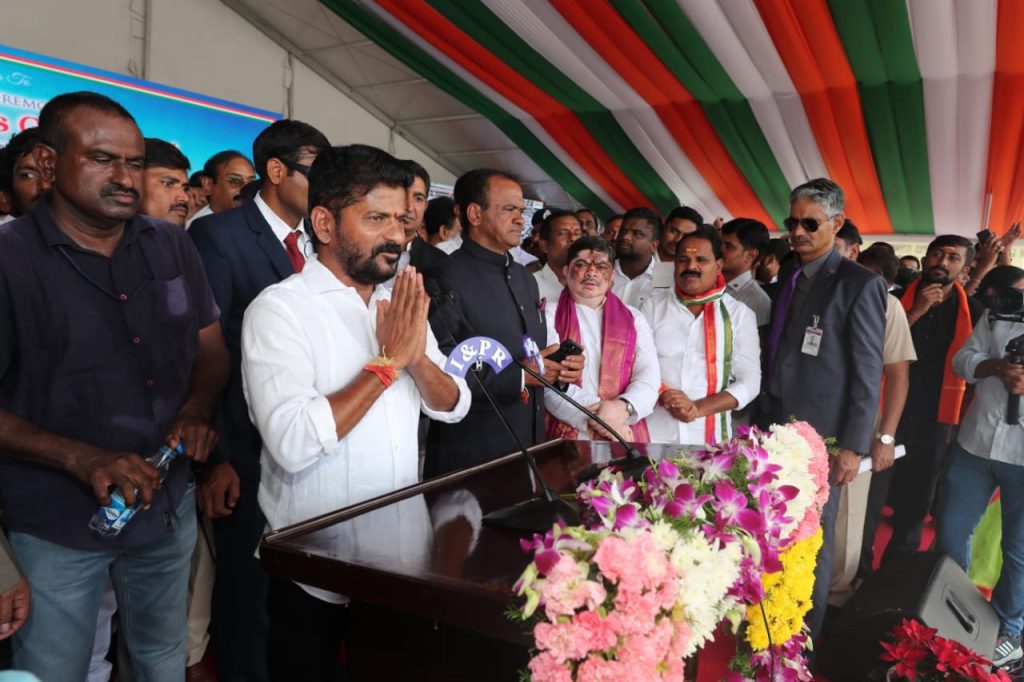
Though assembly results have given an edge to the BJP for 2024 poll, but past outcomes indicate that trends seen in state results seldom carry over to the national stage. It’s yet to seen how INDIA block comprising parties with conflicting interests takes on the mighty BJP. A report by Mudit Mathur
The results of recently held Assembly elections have dealt a blow to the Congress with the party losing two states of Chhattisgarh and Rajasthan, which it ruled earlier, to the BJP, while crashing to a humbling defeat in Madhya Pradesh. Surprisingly, while the grand old party suffered defeat in all the three cow belt states, it registered a gain in total votes polled which points towards BJP’s better poll management at local level. The BJP’s resounding win indicates towards undiminished sway of “Modi Magic” amid allegations of lack of level-playing field with questions being raised over the conduct of the Election Commission and unbridled use of financial resources for publicity during electioneering. The BJP campaign, aimed at religious polarisation, succeeded in blunting the caste census pitch raised by the Congress and the INDIA alliance.
It is believed that strong Hindutva wave swayed poll results in favour of BJP despite visible anger among people over issues concerning their day-to-day life, including record high unemployment and steep price rise. The Congress’ poll promises of restoration of Old Pension Scheme (OPS), farm loan waiver, free supply of electricity, subsidised LPG cylinder, old age pension and pension for women pension failed to cut ice with the voters. Besides, the party’s pitch for caste census for social justice failed to make the desired impact.
On the other hand, triumph of the Congress in Telangana against powerful regional party also signalled how a focussed campaign by the top party leadership can bring a change and favourable results despite factionalism plaguing the state unit. It has a herculean challenge ahead of parliamentary elections to check saffron tide of religious frenzy which is expected to be unleashed before and after consecration (Prana Pratishtha) of Ram temple scheduled for January 22.
There have been allegations about the Election Commission failing to implement “code of conduct” fairly during elections and selectively acting against the Congress leaders. Also, the commission has been accused of overlooking the violations committed by the BJP leaders.
In a development dubbed as unprecedented by the Congress, the Enforcement Directorate (ED) continued raiding opposition leaders even after the imposition of Model Code of Conduct (MCC), even three to four days before the polling date. The opposition leaders alleged that it was done by the BJP to defame them and malign their public image to unfairly gain a political mileage whereas none of those associated with the saffron party was raided.

Most of the political analysts feel that the results have exceeded their assessment about BJP’s performance. Despite the Exit Polls predicting a neck-and-neck contest in Madhya Pradesh and Rajasthan, the BJP won with a comfortable margin over its rival Congress party. Further, it has unexpectedly won Chhattisgarh, where it was seen lagging much behind the Congress during the campaign. Perhaps overconfident Gandhi scion and Congress chief Mallikarjun Kharge counted their chickens before they hatched.
Though initially, BJP sidelined its state leadership to announce its chief ministerial face for the campaign and declared that elections would be contested on PM Modi’s face but in the last leg, it pushed state leaders to hold their fort. With the kind of victory with many stalwart Union Ministers winning the state elections, it may lead to leadership crisis within BJP. The BJP conquered the Congress winning 115 of the total 199 seats in the Rajasthan Assembly.
But the saffron party stunned the Congress with a massive victory in the Madhya Pradesh by winning 163 out of the total 230 seats in the state assembly and overcoming anti-incumbency factor against chief minister Shivraj Singh-led government in the state. Chief Minister Shivraj Singh Chouhan attributed the victory to the double-engine government.
The Congress could win just 66 seats and the Bharat Adivasi Party tasted its maiden win in the state polls from the Sailana constituency near Rajasthan border. Chouhan’s women-centric schemes are believed to have helped the party to overcome the anti-incumbency factor.
In addition to this, Prime Minister Narendra Modi-led the election campaign in the state and Union Home Minister Amit Shah took control of the electioneering on the ground level that seemed to have overwhelmed the Congress. The Congress banked on the leadership of 76-year-old Kamal Nath overlooking claims of aspiring youngsters to come on the central stage. It may be mentioned that the alleged arrogant behaviour of Kamal Nath in the past was blamed for the fall of the Congress government led by him when Jyotiraditya Scindia along with his loyal legislators crossed over to the BJP.
In Raipur, the former Chhattisgarh Chief Minister and BJP leader Raman Singh announced the name of Vishnu Dev Sai as the next Chief Minister of Chhattisgarh during the BJP legislature party meeting. A former Union Minister and four-time Lok Sabha MP, 59-year-old Sai was also a two-time MLA before Chhattisgarh was carved out of Madhya Pradesh. With this, Union Home Minister Amit Shah has fulfilled his poll promise of making a tribal leader as chief minister of Chhattisgarh if the BJP came to power. The BJP had sprung a surprise by winning 54 seats in Chhattisgarh.
In Telangana, the Congress ousted Bharat Rashtra Samithi (BRS) after securing 64 out of the 119 seats. BRS has been ruling the state since 2014, when Telangana was carved out of Andhra Pradesh. Telangana witnessed a triangular contest between the BRS, the Congress and the BJP. The Congress got the historic success on the strength of impressive poll campaign while also benefiting from the anti-incumbency factor against the K Chandrashekar Rao-led BRS government that was seeking third consecutive term.
The emergence of a national party in Telangana against a powerful regional satrap sends political signal for a possibility of re-emergence of national parties in other states too. These parties actually thrive in their states on the strength of estranged voters of the Congress.
Mizoram saw a newly formed party, the Zoram People’s Movement (ZPM), coming trumps in state election in a surprise result. ZPM had announced its candidates and economic agenda well ahead of the polls giving its candidates time to familiarise themselves with their constituencies and vice-versa. The party rejected the idea of cash incentives, arguing it had led to extensive corruption. A significant point that counted with farmers was the ZPM declaration that it would fix minimum support prices for four key cash crops – turmeric, ginger, chilli and broomstick plants.
Though results of these five state assemblies, considered to be semi-final for 2024 parliamentary elections, have given an edge to the BJP, but as has been borne out by past poll outcomes, the voting pattern in parliamentary elections has tended to be different from assembly poll. It is yet to be seen how INDIA block with conflicting interests among alliance parties can take on rising might of the BJP.
Meanwhile, Congress general secretary Jairam Ramesh has said that the next meeting of INDIA alliance will be held in Delhi on December 19. The alliance meeting scheduled for 6th December earlier was deferred as some of the leaders had expressed their inability to attend the same. Samajwadi Party chief Akhilesh Yadav, Trinmool Congress chief Mamata Banerjee and Bihar chief minister Nitish Kumar, who had thrown the spanner, have now agreed to attend the alliance’s fourth meeting.












